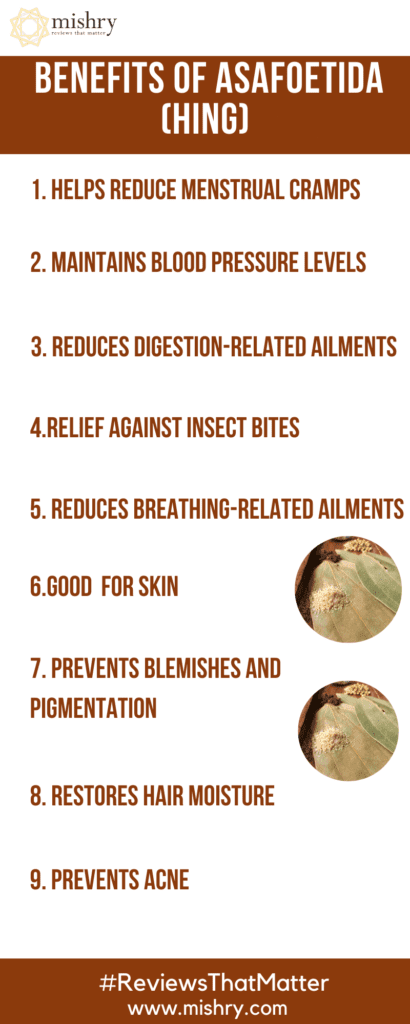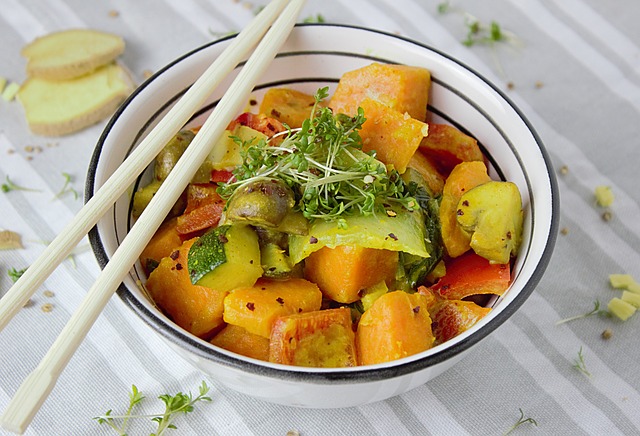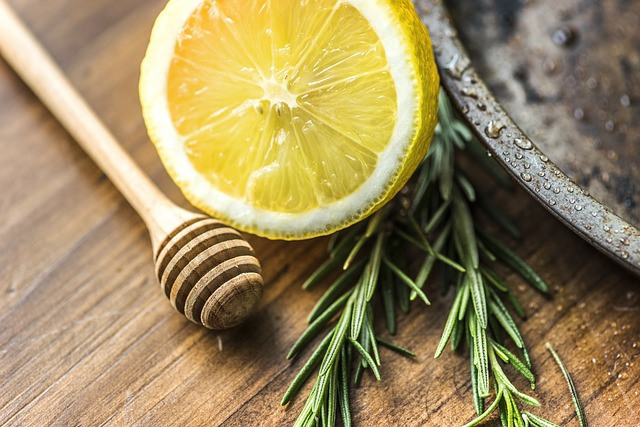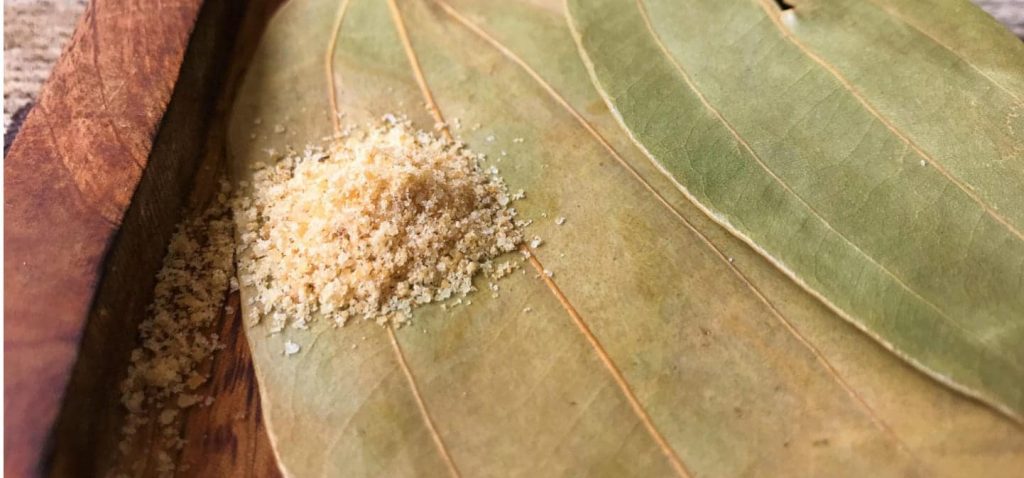Asafoetida, also known as hing is one of the most commonly used ingredients in Asian cuisine. It is a latex gum that you get from the ferula herb. It is used to give an additional flavor and aroma to your foods. However, that’s not all about it. Asafoetida, also known as hing, has the following health benefits as well:

Table of Contents
Asafoetida Benefits: Here’s What You Should Know About Hing
1. Helps to reduce menstrual cramps
One of the main benefits of asafoetida is that it is very helpful for women when they experience severe pain during their menstruation cycle every month. Hing has relaxing properties and it thins blood naturally. When you feel severe pain and cramps in your abdomen, back or legs, all you need to do is drink a glass of buttermilk mixed with a pinch of asafoetida and salt; you will feel instant relief.
Consuming asafetida regularly during your menstrual cycle is believed to reduce your cramps and pain arising because of that. It increases the secretion of progesterone hormone in your body, as a result of which it smoothens the flow of blood.
2. Helps reduce breathing-related ailments
Hing is known for its anti-inflammatory, anti-microbial and anti-fungal properties. Therefore, it provides immense relief against issues such as asthma, bronchitis, cough, and other respiratory ailments. If you have been diagnosed with phlegm in the chest, you may find good results when you consume asafoetida in many forms.
Home Remedy Using Asafoetida For Chest Congestion
A mixture of raw honey, asafoetida or hing and dry ginger powder is considered to be one of the best home remedies for getting relief against chest congestion. Another effective remedy that you can try out is to make a paste by mixing asafoetida and water. Then, apply this paste on your chest and let it remain for a while. This will give you good relief against dry cough, congestion, phlegm, and breathing-related issues.
Also Read: How To Check Common Spices For Adulterants

3. Helps reduce digestion-related ailments
Asafoetida is a healthy way to add flavor to your dishes. You can also benefit immensely from it because of its anti-inflammatory, anti-bacterial and anti-spasmodic properties. Regular consumption of hing can keep you shielded from digestion issues, irritable bowel syndrome, bacterial infection, worm infestations, gas, bloating and other gut-related illnesses. You can dissolve a small piece of asafoetida in water and drink it every day to keep your gut clean and healthy.
4. Helps to keep blood pressure levels under control
Asafoetida is a good source of a compound named coumarin. This is the compound that helps in the smooth flow of blood. Coumarin also helps in the formation of blood clots, thereby helping to keep the blood pressure levels under control at all times. Studies have indicated that consumption of asafoetida or hing regularly can prevent undue fluctuations in blood pressure levels.
Related Reading:
19 Essential Spices For Indian Cooking
Spice Containers: Buying Guide To Select The Best
5. Provides relief against insect bites
Thanks to its excellent anti-inflammatory properties, asafoetida helps in providing excellent relief against insect bites and stings. Insect bites can cause redness, inflammation, and swelling in the affected areas. When you apply a paste of asafoetida and garlic on your skin, it helps you to get relief from the pain and stops the infection from spreading.

Cosmetic Benefits Of Asafoetida Or Hing
1. Keeps your skin young and vibrant
Since asafoetida contains anti-inflammatory properties, it helps to protect your skin from the oxidative stress caused by free radicals. When you apply a face mask containing rose water and a spoon of asafoetida powder at least once or twice a week, you will notice a visible reduction in the signs of aging on your skin such as wrinkles, fine lines, sagging skin, crow’s feet and the like.
2. Helps to control skin blemishes and pigmentation issues
Want to get rid of irregular pigmentation, acne scars and other blemishes on your face? All you should do is to make use of asafoetida to make your skin bright and blemish-free once again. Hing controls the production of Tyrosine, which is the main element responsible for wrinkles, premature aging, and dull-looking skin.
Home Remedy Using Asafoetida For Skin
Make a paste using a spoon of asafoetida powder, sugar and tomato puree. Apply this paste on your face and leave it on for about 15 minutes before washing off with cold water. You will notice that within a few days, your skin tone would have improved naturally. Now, isn’t that a natural and effective way to delay wrinkles?
3. Restores moisture in your hair
Are you looking for an effective solution to restore the shine and moisture in your dull hair? The basic kitchen ingredient, asafoetida, which you use in most of your dishes, can come to your rescue in this case. Thanks to its hydrating and moisturizing properties, asafoetida can be used as a natural, cost-effective and result-oriented conditioner for your hair.
Make a quick mix with a few spoons of yogurt, few drops of almond oil and a spoon of hing powder. Apply this on your dull hair and leave it on for about an hour, before washing it off with lukewarm or cold water. You can do this once a week (twice a week for extremely dry and frizzy hair) for the best results.
4. Controls acne
Are you frustrated because you haven’t been able to find a solution for your acne problems in spite of trying many homemade face masks and natural remedies? Make use of the goodness of asafoetida in these remedies and see the result for yourself. Asafoetida has natural healing properties and it prepares your skin in such a way that it resists the development of acne.
Make a simple face mask using easily available contents such as fuller’s earth, rose water, 3 drops of lemon juice and 2 spoons of asafoetida powder. Leave this mask on your face for 30 minutes before washing off with cold water. When used regularly, these ingredients can control excessive oil production in your skin and prevent the formation of acne.

5. Controls hair fall and improve scalp-health
You may experience hair fall because of many reasons such as unhealthy lifestyle, lack of proper diet, genetics, stress, etc. Regardless of the reason, you will find reasonable results when you use asafoetida to control your hair fall problem. It can be mixed with water and applied all over your hair to improve the strength of the hair follicles to make them stronger than before and less prone to breakage.

This application will also help to keep your scalp healthy and clean so that it forms as the perfect base for the formation of strong hair follicles. Asafoetida plays a vital role in keeping the pH levels of your hair scalp in perfect balance at all times. When you apply asafoetida solution or paste to your scalp regularly, it helps to keep the scalp free from dust, sweat, oils, dryness, and dandruff.
Some points to note about Asafoetida:
Though asafoetida comes with a lot of health and cosmetic benefits, you have to be cautious about certain points when you are consuming this spice regularly.
- In the earlier days, asafoetida was used as a contraceptive medicine. Traditionally, when medical science hadn’t advanced much, people in the villages used to take hing as an abortive pill. So, you need to be very careful about consuming asafoetida in large quantities when you are pregnant or breastfeeding.
- Asafoetida is known for its stress-relieving properties and improving the mood of a person. Therefore, if you plan to use this spice for purely therapeutic purposes, kindly consult a medical expert to be sure you are doing the right thing.
- If you have an existing history of epilepsy or convulsions, stomach-related issues and fluctuating blood pressure levels, you should stay away from consuming asafoetida.
- Asafoetida can reduce the speed of blood clotting; therefore, don’t use it if you at least 2 weeks before surgery to prevent excessive bleeding.
Like many other ingredients that are full of health benefits, and easily accessible in our Indian kitchens, asafoetida (hing) too, needs to be consumed in a regulated manner. If you plan to use it for any of its medicinal or therapeutic benefits, it is best to check with a medical expert before you begin.
Sources
https://www.stylecraze.com/articles/wonderful-benefits-of-asafoetida-on-your-health-and-skin/#gref
https://www.webmd.com/vitamins/ai/ingredientmono-248/asafoetida
FAQs
How can I make out the purity of Asafoetida?
To check for the presence of foreign resin in Asafoetida (rock form), burn small quantity of asafoetida in a stainless steel spoon. Pure Asafoetida will burn like camphor and adulterated Asafoetida will not produce bright flame like camphor.
To check for the presence of common adulterants like soap stone or other earthy matter in Asafoetida (powdered form), shake little portion of the sample Asafoetida with water and allow to settle. Pure Asafoetida will not leave any soap stone or other earthy matter at the bottom. Adulterated Asafoetida will show signs of soap stone or other earthy matter settling down at the bottom.What is the shelf life of Asafoetida?
It is vital to keep asafoetida in an airtight container as its sulphurous odour will effect other foods and spices. It is most commonly available as a powder or granules that can be added directly to the cooking pot. It is also sold in lumps that need to be crushed before using. This is a very powerful spice and the degree of pungency is directly proportionate to the freshness, as it’s volatile oil escapes easily and the essence then fades. Even in its ground state, Asafoetida lasts well over a year if stored properly, away from light and air.
Is Asafoetida used in any other cuisines other than Indian?
Asafoetida is largely imported in India from Iran and Afghanistan. It is commonly seen in various kinds of Indian ‘tadkas’ that is done for lentils, curries or dry preparations. South Indian recipes use Asafoetida a lot more than any part of India. However, this ‘magical spice’ is not very common in global cuisines due to it’s strong fragrance, that may not work with every dish. The only other cuisine outside of India where it is used is Middle Eastern.
Does rubbing Asafoetida paste on a baby’s belly actually help?
Asafoetida paste can work wonders for your baby’s colic and give instant relief. To make the paste, take 1 tbsp of warm water and add a pinch of powdered Asafoetida to it. Mix it well so that the powder absorbs the water and dissolves. Notice that the color of the water changes because of Asafoetida. Once the paste is ready, make sure it is not too warm for the baby. Filter out any solid particles which have not dissolved. Your Asafoetida paste is now ready. Apply the paste on your baby’s tummy in a clockwise direction around the navel area. And within no time, your baby will be less cranky as this paste will help her get rid of the colic cramps.
Is there any substitute of Asafoetida?
There are very few foods/ spices that mimic the flavor of Asafoetida. But a popular one would be a combination of garlic powder and onion powder. Or, fresh garlic chives, also known as ‘hara lehsun’ in hindi, could be a close substitute to the fragrance and taste to Asafoetida, if not the texture.


